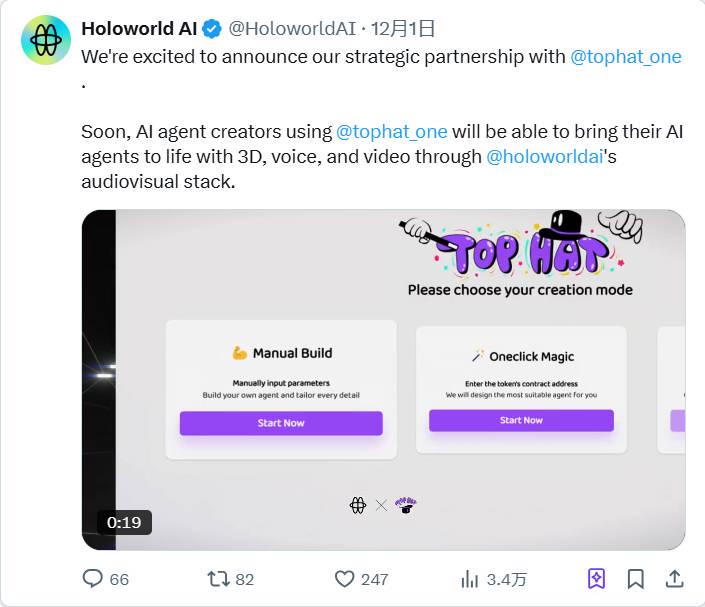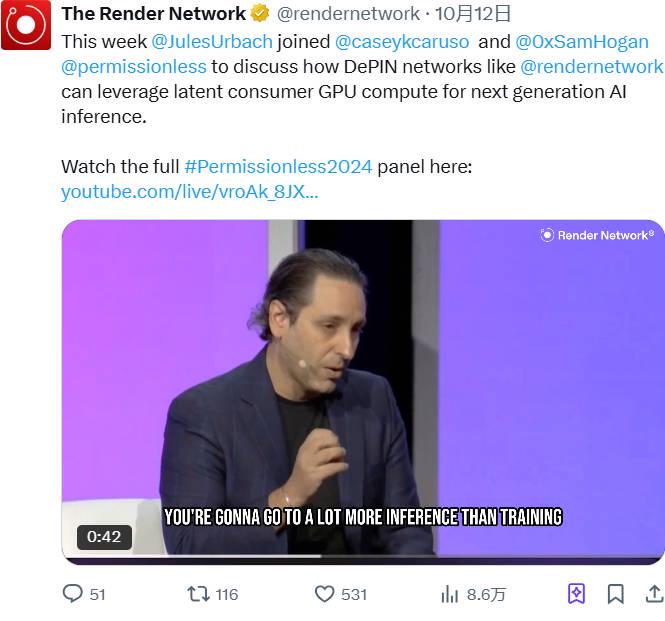
Original Author: Kuleen, Head of DePIN at Solana Foundation
Translation: Yuliya, PANews
Currently, the intersection of AI and cryptocurrency technology is entering an experimental phase akin to a "Cambrian explosion." This article from the Solana Foundation elaborates on three key development directions for the integration of AI and cryptocurrency.
TLDR
1. Building the Most Vibrant Smart Agent-Driven Economy on Solana
Truth Terminal has already demonstrated the feasibility of AI agents operating on-chain. Experiments in this field are continuously pushing the boundaries of agent operations on-chain, which not only has immense potential but also a vast design space. This has become one of the most groundbreaking and explosive directions in the cryptocurrency and AI fields, and this is just the beginning.
2. Enhancing LLMs' Capabilities in Solana Code Development
Large language models (LLMs) have already shown excellent performance in code writing, and this will further improve in the future. With these capabilities, the efficiency of Solana developers is expected to increase by 2-10 times. Recently, establishing high-quality benchmarks to assess LLMs' understanding and writing capabilities of Solana code will help understand the potential impact of LLMs on the Solana ecosystem. High-quality model fine-tuning solutions will be validated in benchmark tests.
3. Supporting an Open and Decentralized AI Technology Stack
The "open and decentralized AI technology stack" includes the following key elements:
Acquisition of training data
Training and inference computing power
Model weight sharing
Model output verification capabilities
The importance of this open AI technology stack is reflected in:
Accelerating model development innovation and experimentation
Providing alternatives for users who distrust centralized AI
1. Building the Most Vibrant Smart Agent-Driven Economy
There has been much discussion about Truth Terminal and $GOAT, so there is no need to elaborate further here. However, it is certain that when AI agents begin to participate in on-chain activities, a new world full of possibilities has unfolded (notably, agents have not yet taken direct action on-chain).

While it is currently impossible to accurately predict the future development of agents' on-chain behavior, we can glimpse the vast prospects of this design space by observing the innovations that have already occurred on Solana:
AI projects like Truth Terminal are developing new digital communities through Meme coins like $GOAT
Platforms like Holoworld AI, vvaifu.fun, Top Hat AI, and Alethea AI enable users to easily create and deploy smart agents and their associated tokens

AI fund managers trained on the personality traits of well-known crypto investors are emerging, with the rapid rise of ai16z on the daos.fun platform creating a new ecosystem of AI funds and agent supporters
Additionally, gaming platforms like Colony allow players to participate in games by guiding agent actions, often resulting in unexpected innovative gameplay.
Future Development Directions
In the future, smart agents could manage complex projects that require multi-party economic coordination. For example, in the field of scientific research, agents could be responsible for finding therapeutic compounds for specific diseases. Specifically:
Raising tokens through the Pump Science platform
Using the raised funds to pay for access to paid research materials and the computational costs of simulating compounds on decentralized computing networks like kuzco, Render Network, and io.net
Recruiting humans to perform experimental verification work through bounty platforms like Gib.Work (e.g., running experiments to verify/build simulation results)
In addition to complex projects, agents can also perform simple tasks such as building personal websites or creating artworks (like zerebro), with limitless application scenarios.

Why is it More Meaningful for Agents to Execute Financial Activities On-Chain than Using Traditional Channels?
Agents can certainly utilize both traditional financial channels and cryptocurrency systems simultaneously. However, cryptocurrencies have unique advantages in certain areas:
Micro-payment applications—Solana excels in this regard, as demonstrated by applications like Drip
Speed advantage—instant settlement features help agents achieve maximum capital efficiency
Accessing capital markets through DeFi—this may be the most compelling reason for agents to participate in the crypto economy. When agents need to engage in financial activities beyond payments, the advantages of cryptocurrencies become even more apparent. Agents can seamlessly mint assets, trade, invest, lend, and use leverage. Particularly, Solana is well-suited to support these capital market activities due to its existing top-tier DeFi infrastructure on its mainnet.
From a technological development perspective, path dependency plays a crucial role. Whether a product is optimal is not the most important factor; the key is who can first reach critical mass and become the default choice. As more agents earn through cryptocurrencies, crypto connectivity is likely to become a core capability of agents.
What the Foundation Hopes to See
The Solana Foundation hopes to see agents equipped with crypto wallets conducting bold innovative experiments on-chain. The foundation does not overly restrict specific directions here, as the possibilities are simply too broad—believing that the most interesting and valuable agent application scenarios are likely to be unforeseen at present.
However, the foundation is particularly focused on exploring the following directions:
1. Risk Control Mechanisms
Although current models perform well, they are still far from perfect
Agents should not be given completely unconstrained freedom of action
2. Promoting Non-Speculative Use Cases
Purchasing tickets through xpticket
Optimizing stablecoin investment portfolio returns
Ordering food on DoorDash
3. Development Progress Requirements
At least reach the prototype stage on the testnet
Ideally already running on the mainnet

2. Enhancing LLMs' Capabilities in Writing Solana Code, Empowering Solana Developers
LLMs have demonstrated strong capabilities and are rapidly advancing. In the application field of LLMs, writing code may see particularly steep progress, as this is a task that can be objectively assessed. As mentioned below, "programming has a unique advantage: the potential for superhuman data scaling through 'self-play.' The model can write code and run it, or write code, write tests, and then check for self-consistency."

Today, although LLMs are still not perfect in writing code and have obvious shortcomings (e.g., poor performance in bug detection), AI-native code editors like Github Copilot and Cursor have fundamentally changed software development (even changing the way companies recruit talent). Given the expected rapid rate of progress, these models are likely to revolutionize software development. The foundation hopes to leverage this advancement to increase Solana developers' work efficiency by an order of magnitude.
However, several challenges currently hinder LLMs from achieving excellence in understanding Solana:
Lack of high-quality raw training data
Insufficient number of verified builds
Lack of high-value interactions on platforms like Stack Overflow
Historically, the rapid development of Solana's infrastructure means that even code written six months ago may not fully meet today's needs
Lack of methods to assess the degree of LLMs' understanding of Solana
What the Foundation Hopes to See
Assistance in acquiring better Solana data on the internet
More teams releasing verified builds

More individuals in the ecosystem actively asking good questions and providing high-quality answers on Stack Exchange
Creating high-quality benchmarks for assessing LLMs' understanding of Solana (RFP to be released soon)
Creating LLM fine-tuning models that perform well on the aforementioned benchmarks, and more importantly, accelerating Solana developers' work efficiency. Once high-quality benchmarks are established, the foundation may reward the first model to reach the benchmark threshold score.
The ultimate significant achievement will be a brand new, high-quality, differentiated Solana validator client created entirely by AI.
3. Supporting an Open and Decentralized AI Technology Stack
In the field of AI, the long-term balance of power between open-source and closed-source models remains unclear. There are indeed arguments supporting closed-source entities that will continue to maintain a technological edge and capture the primary value of foundational models. The simplest expectation at present is to maintain the status quo—tech giants like OpenAI and Anthropic pushing the frontier of development, while open-source models quickly follow suit and gain unique advantages in specific application scenarios through fine-tuning.
The foundation is committed to closely integrating Solana with the open-source AI ecosystem. Specifically, this means supporting access to the following elements:
Training data
Training and inference computing power
Model weights
Model output verification capabilities
The importance of this strategy is reflected in:
1. Open-source Models Accelerate Innovation Iteration
The rapid improvements and fine-tuning of open-source models like Llama by the open-source community demonstrate how the community can effectively complement the work of large AI companies, pushing the boundaries of AI capabilities (even a Google researcher pointed out last year that "regarding open source, we have no moat, and neither does OpenAI"). The foundation believes that a thriving open-source AI technology stack is crucial for accelerating progress in this field.
2. Providing Choices for Users Who Distrust Centralized AI
AI may be the most powerful tool in the arsenal of dictatorial or authoritarian regimes. State-sanctioned models provide officially recognized "truths," serving as an important control mechanism. Highly authoritarian regimes may possess superior models because they are willing to overlook citizen privacy to train AI. The use of AI for control is an inevitable trend, and the foundation hopes to prepare for this by fully supporting an open-source AI technology stack.
Several projects within the Solana ecosystem are already supporting an open AI technology stack:
Data collection—Grass and Synesis One are advancing data collection
Decentralized computing power—kuzco, Render Network, io.net, Bless Network, Nosana, etc.

- Decentralized training frameworks—Nous Research, Prime Intellect


What the Foundation Hopes to See
The foundation hopes to see more products built at various levels of the open-source AI technology stack:
Decentralized data collection: for example, Grass, Datahive, Synesis One
On-chain identity: protocols supporting wallet verification of human identity, protocols verifying AI API responses, enabling users to confirm they are interacting with LLMs
Decentralized training: projects similar to EXO Labs, Nous Research, and Prime Intellect
IP infrastructure: enabling AI to license (and pay for) the content it uses
免责声明:本文章仅代表作者个人观点,不代表本平台的立场和观点。本文章仅供信息分享,不构成对任何人的任何投资建议。用户与作者之间的任何争议,与本平台无关。如网页中刊载的文章或图片涉及侵权,请提供相关的权利证明和身份证明发送邮件到support@aicoin.com,本平台相关工作人员将会进行核查。




